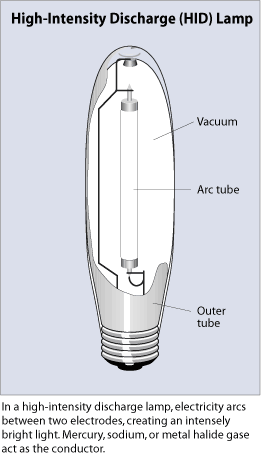high-intensity discharge lamp

A high-intensity discharge lamp is a lamp that consists of a sealed arc tube inside a glass envelope, or outer jacket. The inner arc tube is filled with elements that emit light when ionized by electric current. High-intensity discharge (HID) lamps provide the highest efficacy and longest service life of any lighting type. They can save 75–90% of lighting energy when they replace incandescent lamps.
HID lamps use an electric arc to produce intense light. Like fluorescent lamps, they require ballasts. They also take up to ten minutes to produce light when first turned on, because the ballast needs time to establish the electric arc.
Because of the intense light they produce at a high efficacy, HID lamps are commonly used for outdoor lighting and in large indoor arenas. Since the lamps take awhile to establish, they are most suitable for applications where they stay on for hours at a time. They are not suitable for use with motion detectors.
Types of high-intensity discharge lamps
These are the three most common types of HID lamps:
You can use the chart below to compare these types of lamps. If you don't already, it helps to understand basic lighting principles and terms before making comparisons.
| High-intensity discharge lighting type | Efficacy (lumens/watt) |
Lifetime (hours) |
Color rendition index (CRI) | Color temperature (K) | Indoors/Outdoors |
| Mercury vapor | 25–60 | 16,000–24,000 | 50 (poor to fair) | 3200–7000 (warm to cold) | Outdoors |
| Metal halide | 70–115 | 5000–20,000 | 70 (fair) | 3700 (cold) | Indoors/outdoors |
| High-pressure sodium | 50–140 | 16,000–24,000 | 25 (poor) | 2100 (warm) | Outdoors |
